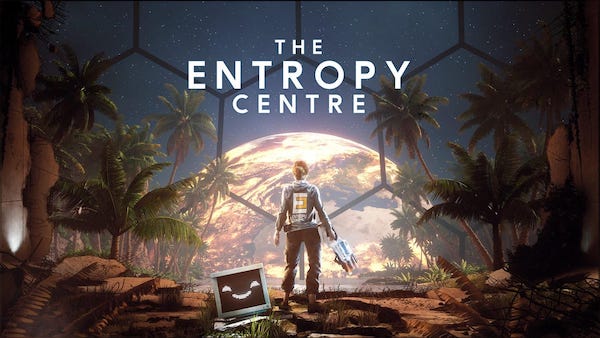The Entropy Centre Review, by a diehard Portal fan-girl.
Guest writer Nina, returns to the fray with a detailed looks at this Indie Portal wannabe, The Entropy Centre.
Before kicking off this review I feel I need to come clean: I am an absolute diehard Portal fan. Proof of this can be found in one of my earliest Koru-Cottage pieces, where I essentially spent a paragraph riffing about how Portal 2 was one of the best narrative experiences I’ve ever had. The announcement of The Entropy Centre, developed by indie dev Stubby Games, reawakened that Portal-shaped spark in my gamer heart that had been dormant for years. But when I was given the chance to review it, I became apprehensive.
My status as a hardcore Portal lover made me both the best… and worst person to review The Entropy Centre.
On one hand, I feel I have a pretty good understanding of what makes a good first-person-shooter-puzzle game. But on the other hand, I feared I wouldn’t be able to view this game objectively. I was afraid that by the end, I’d just find myself saying ‘it’s good, but it isn’t Portal.’ My fears only grew as the extended previews and trailers started dropping. It was clear that this game was wearing its inspiration on its sleeve. A cool sci-fi gun with wacky abilities, cute robots that are actually murder machines, an abandoned science laboratory based around completing puzzles using said wacky sci-fi gun? I mean, come on. However, I am delighted to report that those fears turned out to be unfounded.

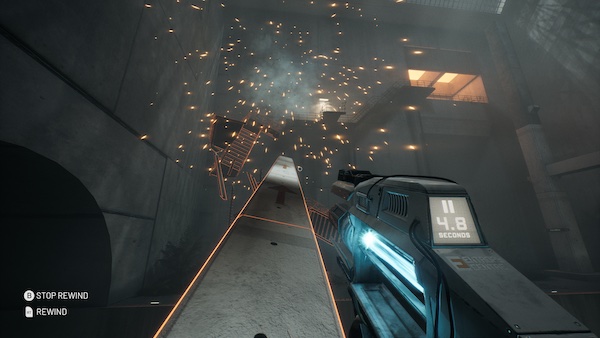
I will try my absolute damndest to keep my comparisons between this game and “the P game” to a minimum. But that may prove difficult because as I said, this game wears its inspiration on its sleeve.
I’ll start by getting the technical stuff out of the way. Graphically, this game looks phenomenal. Reflections move and bounce over the surface of your gun. The environment is alive with accurate lighting and shadows that react as you move around. All of this was only enhanced by a steady 60 fps. That being said, I did experience some quite hefty frame drops during bigger action setpieces. So hefty that they crashed the game twice. But overall, I would still say that technically The Entropy Centre is very sound. Considering just how visually beautiful this Indie game is, I think any issues can be forgiven.
A perfect blend of original and inspired, the Entropy Centre (the place, that is) is a sight to behold.
The architecture and overall style of the Centre are all heavily inspired by Portal Gleaming white panels overgrown with flora, stylised cubes with various effects and functions. Even the orange and blue colour palette iconic to the portal gun is used on a few occasions. Now, there is a difference between being an inspiration and being an off-brand copy. The latter would be devastating. But the Entropy Centre walks that line perfectly.
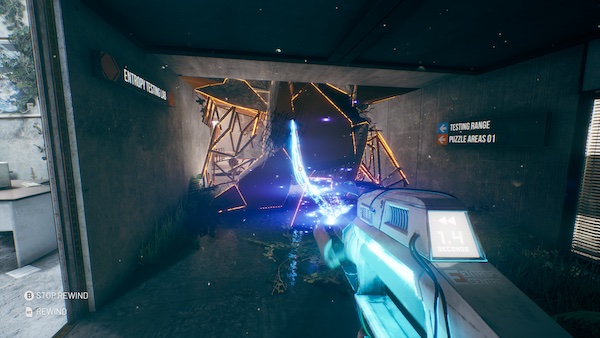
The devs knew exactly what they were doing. Obvious pieces of inspiration feel earnest and endearing, like they came from a place of respect for the source material. And original elements unique to The Entropy Centre feel crafted to slot into the pseudo-Portal vibe of the rest of the world seamlessly. Honestly, Stubby Games and Valve could suddenly announce that the Entropy Centre is canonically another branch of Aperture Science, and it would totally make sense. All of this culminates in a world that ultimately feels immersive.
The Entropy Centre’s story aligns more closely with that of Portal over Portal 2. There are no deep, personal narratives, but rather, a plot-driven story focused around the Entropy Centre (place, not game) itself. As you progress you uncover through lore titbits what the Centre was and what they did. The primary goal of the game is to figure out exactly what happened to leave it abandoned. This simplicity didn’t bother me at all. In fact, it’s what I expected.
The Entropy Centre does the job.
Portal 2’s story is one of the best to have ever graced gaming; it would be unrealistic to hold The Entropy Centre to such an expectation. You won’t find yourself laughing your ass off at the dialogue or feeling particularly invested in the characters, but The Entropy Centre’s story is still interesting and paced well enough to hold your attention. There were even a couple story beats that genuinely left me shook. So while it’s not perfect, it absolutely does the job.
Now, the nitty-gritty. The thing that would absolutely determine if this game would sink or swim: the puzzles. But before I start, I want to first break down what made Portal’s puzzles work so well. I wanted to keep such comparisons to a minimum, but in this case the context will prove very important later.
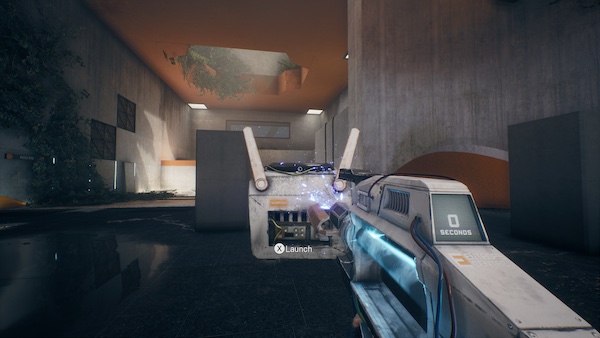
The central doctrine behind Portal’s puzzle design can be summarised by a single sentence: a simple concept with increasingly complex ways of applying it. As soon as Chell picked up the portal gun, you understood exactly how it worked. Shoot a portal at point A ,then point B, pass through the threshold and viola, you’ve moved from point A to B instantaneously.
The simple elegance of the portalling mechanic allowed Valve to throw some pretty crazy challenges at you. You could use portals to move light bridges, sneak up behind turrets, or redirect vortexes to carry you across chasms. Or, most famously, you could fire a portal at the ground from a high place, leap inside, and send yourself flying through the air. As GLaDOS excellently put it: “speedy thing goes in, speedy thing goes out.” All of this summarises the core reason why Portal’s puzzles worked so well. They were able to perfectly walk that line of being challenging without being frustrating because of that doctrine: Simple concept, complex applications. Keep that little mantra in mind as we now break down the puzzles of The Entropy Centre.
If I could turn back time…
The core mechanic of The Entropy Centre is time reversal. Think those Christopher Nolan movies Tenet and Memento. When you fire the ‘Handheld Entropy Device,’ at an object, that object rewinds back to a previous position or state it was in however many seconds ago. Already, it’s clear that this concept, while very cool, is a little less straightforward than portals. But that didn’t stop the devs from coming up with some pretty fun ways of applying it. Some of my favourites included rewinding the direction of giant spinning fans to pull you across gaps and using rewound fallen debris like makeshift elevators. But those are mostly gimmicks.
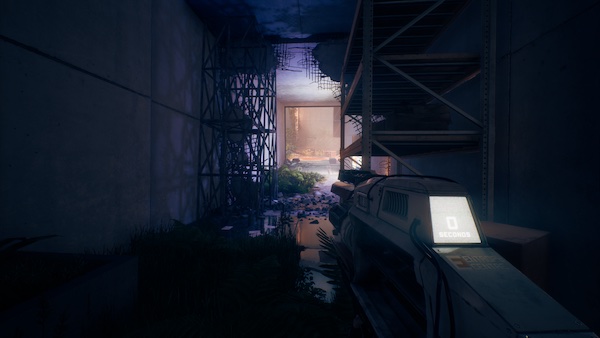
The main focus is much the same as Portal; you must use a selection of cubes, buttons, elevators and other gadgets to navigate test chambers. The Entropy Centre borrows ideas such as light bridges, laser cubes and bounce pads from Portal, but it also introduces some original elements that specifically compliment the entropy device’s unique abilities. I’d love to go into some of my favourites, but half the fun of these kinds of games is discovering new puzzle elements. And as promised, I want to keep this review spoiler-free. But trust me, some of the things the devs came up with make me believe that no one at Stubby Games has an IQ less than 110.
And that brings us back to that little mantra I mentioned: simple concept, complex applications. The Entropy Centre is undeniably clever, but sometimes, it feels a little too clever. If Portal adhered to ‘simple concept, complex application,’ The Entropy Centre adheres to ‘complex concept, complex application.’ Portal had your brain doing somersaults trying to figure out how to use portals to solve a puzzle. The Entropy Centre has your brain doing somersaults trying to figure out how the entropy device even works, and then doing more somersaults trying to figure out how to use it to solve a puzzle.
The result is The Entropy Centre slipping into the realm of frustration a little too often.
Now, I can already hear the thoughts of some of you; I just wasn’t smart enough. It was too hard for me, and that’s why I’m making this critique. Such an argument brings us closer to the general ‘difficulty in videogames’ debate than I’d like. So all I’ll say is this. There will be a number of people who will disagree with me and think that The Entropy Centre’s core concept isn’t that complicated at all. But I can’t help but feel that those people will be in the minority. Because the fact is, time reversal is a difficult mechanic to wrap your head around. Purely because it is not intuitive and, therefore, inherently harder to grasp. It lacks that simple elegance that made portals work so well for Valve.
At its best, it’s a complex but fascinating puzzle in itself. At worse, it feels obtuse and, on occasion, just irritating.
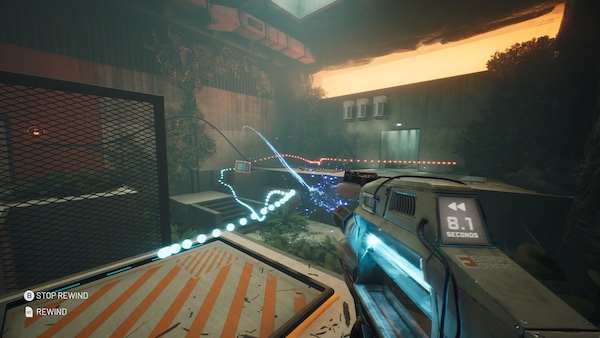
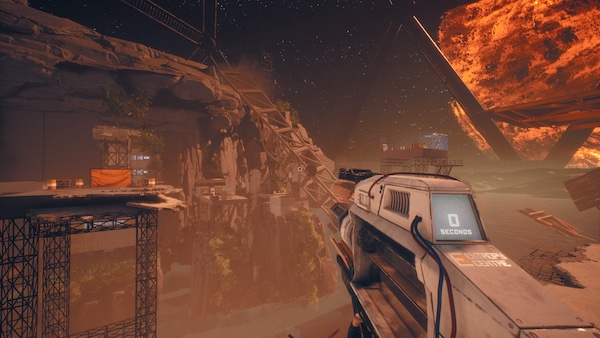
This problem is only enhanced by a few other design choices with the puzzles themselves. Instead of relying on puzzle design alone to provide difficulty, there are a few instances where sneaky tricks are used to artificially make a puzzle harder. Some examples include hiding a cube in a weird place or angling a door in such a way that it appears to be on a flat ledge, but in reality is sitting high on a step. These things are annoying because they’re not only cheap, they’re unnecessary. The rest of this game is so ridiculously clever that the devs shouldn’t need to use cheap tricks. Their puzzles are hard enough on their own!
As a Portal diehard, what do I think?
Honestly, I think this game is, on the whole, remarkable. It genuinely feels like the devs at Stubby Games are a collection of Portal fans who got sick of waiting for Valve to make another game. So they got together one day and decided to do it themselves. This isn’t a successor to Portal, more an ode. It’s art, mechanics and premise is very original, and yet wears its inspiration on its sleeve in a very endearing way. While the puzzles themselves lack that simple elegance that made Portal so great, they are by no means ruined by it.
If you are a Portal fan, play this game. Because issues aside, you can feel the soul that has been poured into this game. I believe it will fill that Aperture-shaped hole in all our hearts quite nicely. It did for me.


